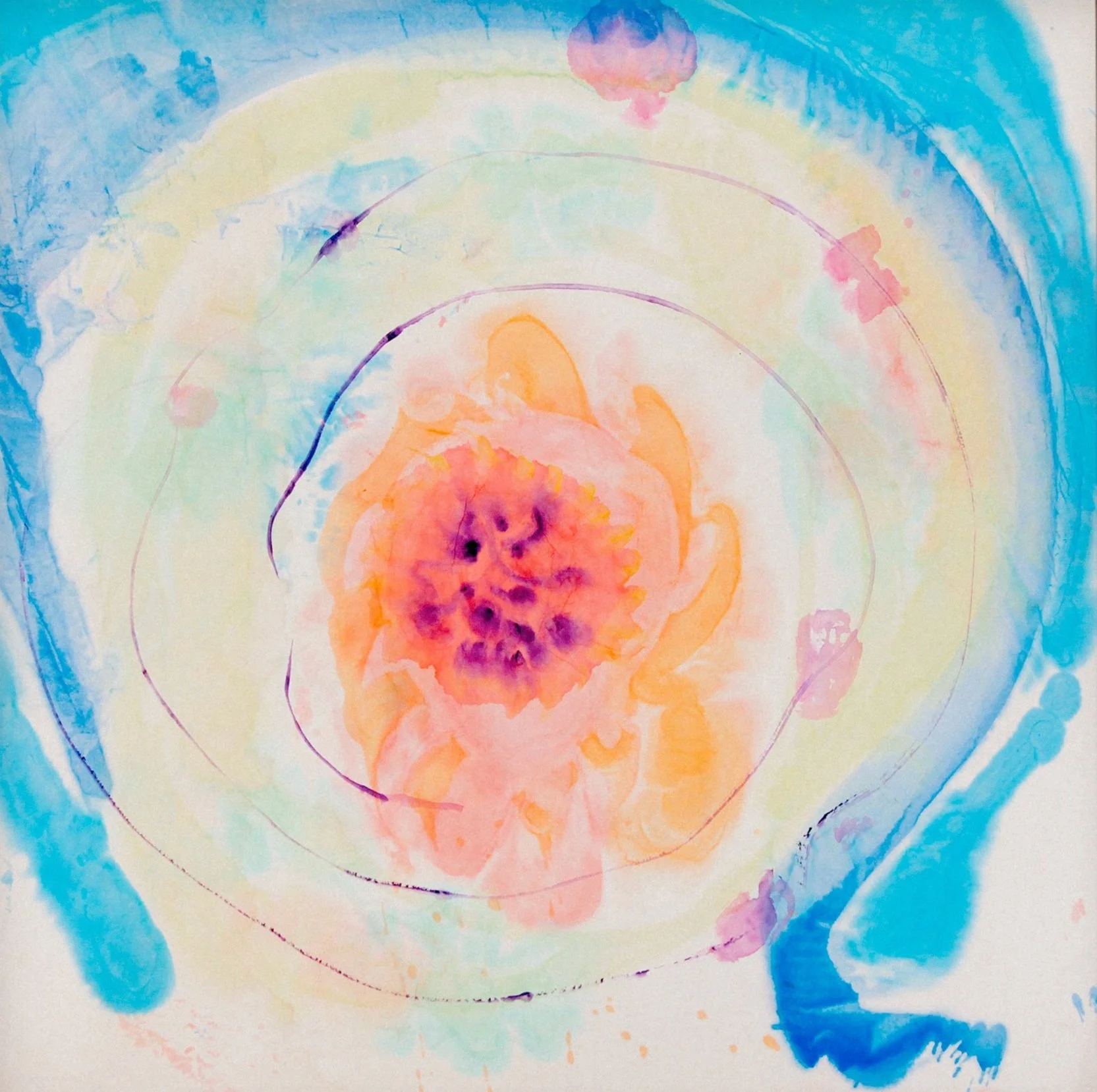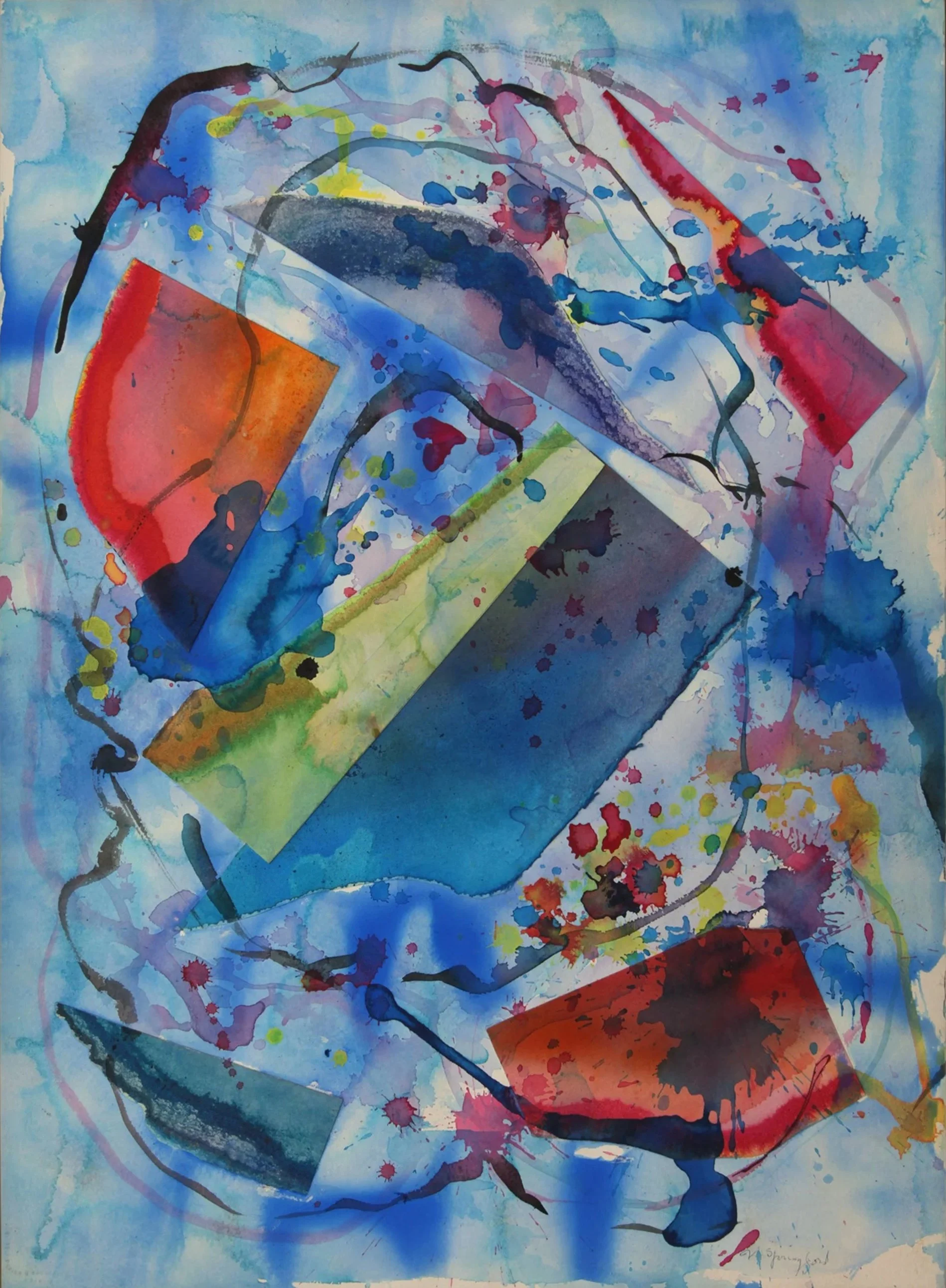
The Hidden Order of Nature
Vivian Springford and the Tao of Painting
The Hidden Order of Nature
Vivian Springford and the Tao of Painting
Vivian Springford’s art was never a matter of formalist invention. From the beginning, her abstractions were shaped by a deep engagement with Eastern philosophy and aesthetics, especially Taoist thought. She often cited Asian calligraphy as her true source, and her personal library — filled with annotated translations of Lao-Tzu and Confucius — makes clear how enduring these influences were. What emerged was not an imitation of Asian art, but a lifelong attempt to align gesture, color, and perception with a Taoist understanding of nature.
In Taoist painting, landscape is not scenery to be described but a field of energy in which human beings participate. Mountains, rivers, clouds, and empty space are not depicted literally; they serve as metaphors for the balance between matter and void, presence and absence. Springford’s early calligraphic works reveal this same orientation. On rice and mulberry paper, she rehearsed sweeping gestures until they became inevitable — a discipline of hand and body that mirrors the Taoist principle of wu wei, effortless action achieved through practice. The results were not accidents of paint but meditations in rhythm and balance.
To master the brush is to master the breath.
These early gestures contain the seed of everything that would follow. They taught Springford that painting was not a record of thought, but a living extension of it — a way to join motion, breath, and attention in a single act.
From this discipline of motion emerged a new kind of vision — one that would soon rise above the body, above the brush, to see the world itself as gesture.
Early Vivian Springford, c. 1957. Acrylic on rice paper. One of the rare works in which Springford directly engaged with the traditions of Chinese calligraphy, balancing gesture and emptiness in the Taoist sense of presence and void.
Vivian Springford on the roof of her West 25th Street studio, c. 1958-59. Works from her Chaos series, executed in acrylic and crayon on mulberry paper mounted on canvas, surround her. These early pieces marked her transition from figurative drawing to calligraphic abstraction.
Left: Yūichi Inoue at work. Right: Springford’s Calligraphy painting mounted as a scroll, exhibited at Preston Gallery in 1963.
A rare progression of four works tracing Springford’s movement from pure gesture to pictorial form. The earliest study (top left) captures the unmediated act of the brush — a direct expression of energy and rhythm. Subsequent works gradually introduce color, layering, and symbolic structure, transforming calligraphic motion into image. The final painting (bottom right) resolves this evolution into a dynamic balance of gesture and form — the gesture becoming landscape, the movement becoming vision.
Seeing from Above and Returning Within
By the early 1960s, Springford’s disciplined calligraphic practice evolved into the Rice Paper Mountings. For decades, these works were seen as mysterious experiments. Now they can be recognized as aerial landscapes — abstracted grids and flows resembling New York streets seen from her rooftop, or patterns of water and terrain glimpsed from above. Like Taoist landscape painters, Springford shifted perspective away from the human figure to energy itself: circulation, rhythm, movement.
In Taoist geomantic theory, the movement of energy through mountains and rivers — known as longmo, or dragon veins — describes the hidden currents that animate all form. Centuries apart, Fang Congyi’s mountains and Springford’s Expansionists record the same unseen flow of qi: one in ink and mist, the other in pigment and light.
“What she painted was never the landscape itself — but the current of energy that moved through it.”
Her Chromatic Pools extend this vision further. The revelation that Morning Glory depicted Yellowstone’s geothermal spring reframes the entire series — not detached circles of color, but living images of nature’s deep interior. In Taoist thought, water is the supreme metaphor for the Tao — yielding, reflective, yet powerful enough to shape stone. Springford’s pools embody that principle: color moving outward in slow expansion, stillness that is also flow, transparency that conceals immeasurable depth.
These were not landscapes to be entered, but fields to be contemplated — portals between the visible and the invisible, where matter becomes motion and motion becomes light. All things arise from the void and return to it.
The Expansionists carried this energy to another register. Inspired by volcanic force, they turned destruction into creation — eruptions that both clear and renew. Taoist cosmology makes no distinction between these states; all transformation is part of the same continuum. Springford’s canvases translate this rhythm into color and form, turning upheaval into equilibrium.
Her late works bring that logic inward. The Scuba Series immerses the viewer within water itself, dissolving the boundary between self and environment. The color fields deepen to oceanic pressure; collage fragments drift like submerged ruins. These paintings are not simply about seeing, but about the dissolution of seeing — immersion in the depths of perception.
The final Bone Sculptures — fragile verticals built from stacked vertebrae and shells — distill that vision into silence. Created as her sight failed, they resemble both standing stones and offerings: matter returning to energy, form ascending toward void.
Across five decades, she followed the Tao of painting — gesture becoming pool, pool becoming eruption, eruption dissolving into cosmos.
Springford’s oeuvre unfolds as a single meditation on nature’s hidden order. Like the Taoist painters she admired, she sought not representation but attunement — to paint not what she saw, but the flow of energy that moves through all things.
Vivian Springford, Rice Paper Mounting, c.1962–63. Acrylic on rice paper mounted on asian scroll. Early example of Springford’s aerial compositions, abstracting the geometry of New York streets into rhythmic flows of energy.
Details (left to right):
Fang Congyi, Cloudy Mountains, ca. 1360–70, ink on paper scroll. Vivian Springford, Expansionist Series, ca. 1974, acrylic on paper mounted to board.
Both reveal the invisible movement of energy through matter — what Taoist painters called longmo, or “dragon veins.” Fang’s ink currents and Springford’s color fissures each trace qi as it animates mountains, rivers, and molten terrain.
Vivian Springford, Rice Paper Mounting, c.1962–63. Acrylic on rice paper mounted on canvas. Early example of Springford’s aerial compositions, abstracting the geometry of New York streets into rhythmic flows of energy.
Acrylic and collage on board. One of the last works completed before her loss of sight, uniting her earlier color language with a submerged, interior vision. Collection Vivian Springford Archive.
Untitled Bone Sculptures, c.1985 Created during the final years of Springford’s artistic life, these fragile forms echo her Cosmos paintings — structures dissolving into void, gestures made three-dimensional.








